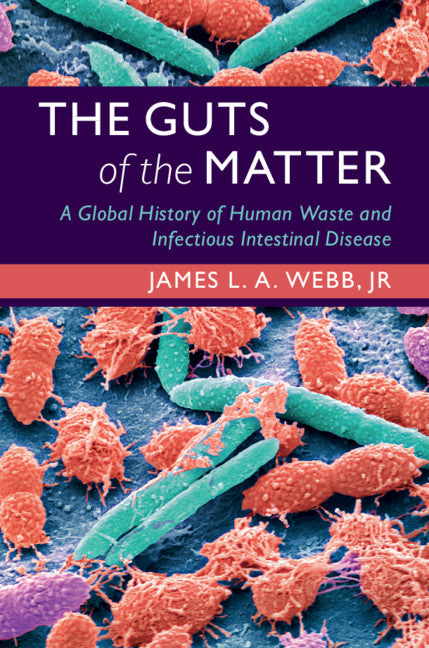Freshly Printed - allow 8 days lead
Couldn't load pickup availability
The Guts of the Matter
A Global History of Human Waste and Infectious Intestinal Disease
This engaging interdisciplinary study integrates the deep histories of infectious intestinal disease transmission, the sanitation revolution, and biomedical interventions.
James L. A. Webb, Jr (Author)
9781108737067, Cambridge University Press
Paperback / softback, published 12 December 2019
222 pages, 21 b/w illus. 1 table
22.7 x 15.2 x 1.3 cm, 0.33 kg
'The combination of chronological breadth and descriptive detail will make this book useful for a wide audience of scholars and professionals.' Randall M. Packard, Bulletin of the History of Medicine
The Guts of the Matter is a study of our oldest ecological problem: the transmission of infectious intestinal disease from human waste. Spanning the early hominin era to the present, this book explores the evolution of human waste disposal practices, the use of faeces and urine as fertilizer, and the changing patterns of transmission of intestinal pathogens and parasites. Chapters trace the spread of viral, bacterial, and helminthic infections through the early processes of globalization and track the uneven successes of the sanitation revolution in recent centuries. The book also provides an overview of the cultural practices that influence the transmission of infectious intestinal disease and the impacts of biomedical advances such as oral rehydration therapy and vaccination. Webb's impressive breadth and meticulous research is invaluable for students of public health, environmental history, global history, and medicine.
Introduction
1. Pathogens and parasites
1.1 Intestinal viruses, protozoa, and bacteria
1.2 Intestinal worms
1.3 Determinants of disease transmission
1.4 Changing perspectives on childhood diarrheal diseases
1.5 The microbiome
1.6 Historical epidemiology and contemporary interventions
2. Early change
2.1 Rethinking the first epidemiological transition
2.2 Patterns of vulnerability
2.3 Zones of infectious intestinal disease
2.4 Eurasian attitudes toward human waste
2.5 Early urban sanitation
3. Diffusion and amplification
3.1 The early diffusion of infectious intestinal disease to the Americas
3.2 The uses of human and animal wastes
3.3 Preindustrial urban sanitation redux
3.4 Urban crisis and the emergence of public health movements
3.5 Global cholera
4. Innovations
4.1 The limited practical import of discoveries in epidemiology and bacteriology
4.2 Early sewerage
4.3 Death by sewage
4.4 The 'dry earth' and 'tub-and-pail' systems
4.5 Sewage farming and trenching
4.6 Flies, household hygiene, and contaminated milk
4.7 The typhoid fever vaccine
4.8 Water filtration and disinfection
5. Adoptions and adaptations
5.1 Water and sanitation in Latin America
5.2 European colonial military sanitation
5.3 Water and sanitation in East Asia
5.4 Water and sanitation in tropical Africa
5.5 Water and sanitation in India
5.6 Global sanitation at mid-twentieth century
6. The struggle against hookworm disease
6.1 Early control programs
6.2 The Rockefeller Sanitary Commission for the Eradication of Hookworm Disease
6.3 The Rockefeller Foundation's international programs
6.4 International Health Board (1916–1927)
6.5 Anemia as a diagnostic conundrum
6.6 The unmet challenges of human feces disposal
6.7 Assessments of the hookworm campaigns
7. An era of optimism
7.1 Sanitary practices: soap, refrigeration, and screens
7.2 Vaccines against poliomyelitis
7.3 The revolution of oral rehydration therapy
7.4 The World Health Organization and sanitation initiatives
7.5 The first and second United Nations development decades (1960s–1970s)
7.6 The international drinking water and sanitation decade (1980s)
8. Global health and infectious intestinal disease
8.1 The infant formula controversy
8.2 The child survival revolution
8.3 A new campaign to eradicate poliomyelitis
8.4 Total community led sanitation
8.5 Open defecation and the struggle for modernity
8.6 Deworming the world
8.7 Rotavirus vaccine
8.8 The seventh cholera pandemic
8.9 Infectious intestinal disease today
Conclusion
Bibliography.
Subject Areas: History of science [PDX], Environmental medicine [MMR], History of medicine [MBX], General & world history [HBG]


